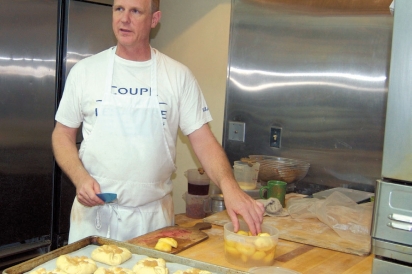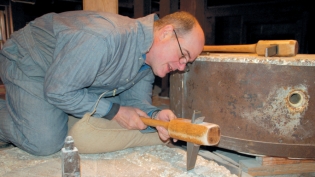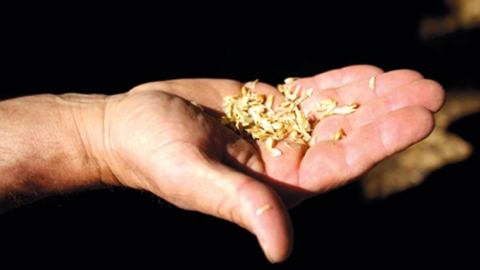Surfing Amber Waves of Grain, Part III: Bakers Rise to the Challenge
"It isn’t bread that feeds you; it is life and the spirit that feed you through bread.”
—Johann Angelus Silesius (1624–1677)“Bread deals with living things, with giving life, with growth, with the seed, the grain that nurtures. It’s no coincidence that we say bread is the staff of life.”
—Lionel Poilâne, French master baker (1945–2002)Companion: “one with whom you would eat bread,” from the Latin companionem
Powerful movements have a flash point, a moment when the long-gathered fuel has dried to perfection and joins with the tinder, containing a tiny focused flame that has been passed from hand to hand and kept alive with puffs of hopeful breath. At that moment, fire leaps forth and potentiality is transformed into something living in the world strong enough and large enough for all to know it is real.
For over a century, the arts of growing, milling and crafting food from local grains were virtually absent from our foodshed. In this culmination of our exploration of the trinity of farmer, miller and baker returning to the heart of our local food system, we acknowledge those who have kept the flame alive for many years, mentors like West Marin oven maker Alan Scott and miller Joseph Vanderleit, (see “Amber Waves of Grain,” Summer 2012 and Fall 2012), in the telling of the stories of those who are stoking the flames today, bakers like Craig Ponsford, Mike Zakowski and Marianne Wiener.
These local bakers honor the lovingly grown, properly milled grains placed before them by baking with natural leavenings, patience, artistry and the fire of a movement, making the bakery once again a place of healthy and delicious sustenance.
CRAIG PONSFORD
Craig Ponsford is a former chairman of the Bread Bakers Guild of America and the first American to win the Coupe du Monde de la Boulangerie (The World’s Cup of Baking). With his family, Craig founded Sonoma’s Artisan Bakers in 1992. In 2006, after 14 years of a lot of hard work, baking wonderful bread and building a great brand, Craig sold his share of the business to a private equity firm, agreeing to stay involved. When, according to Craig, it became clear that the new partners weren’t interested in continuing his vision, he left the company.
Craig had been a friend and fan of renowned miller Joe Vanderleit for many years and Craig says that when Joe heard that Craig had left Artisan Bakers, Joe immediately picked him up out of his funk and put him to work in his lab kitchen in Woodland, California. Thus began the transformation of one of the world’s best white-flour bakers.
“Joe Vanderleit was my main influence with his whole grain milling. I came to work for him and I started with 70% white flour and 30% whole milled grain and one day Joe came in and asked me, ‘Why are you bringing this in here? Why aren’t you using my flours 100%?’ It was the last day I ever used white flour. For 18 years Joe had preached to me and it took something that seemed very bad at the time for me to understand how profoundly right Joe was,” says Craig.
As Craig puts it, “Baking with whole grains versus white flour is very different in the big picture. Yeasted long-fermented breads—the texture, structure and control I was used to working with—were no longer in place. So being in this commitment to no white flour has motivated me to become a master at whole grain.”
He describes it as being an artist who is given a completely new medium to work with—everything he knew went out the window. Craig notes that he immediately found he needed far less yeast to leaven and less starter to inoculate and fermentation went a lot faster than usual. It seemed that the whole milled grains were providing substantially more nutrients.
Competition with himself and others has always been a path to mastery for Craig—hence his gold in the 1996 Coupe du Monde de la Boulangerie. Craig explained to me that the competition itself had been created out of concern that the craft of artisan bread baking was being lost in France. This love of working hard to master a new subject and competition is part of what compelled him to open a new retail bakery, Ponsford’s Place, in San Rafael last year. Serving his customers forces him to continually practice with his new medium as he tries to choose the most challenging and difficult, and the most delicious, offerings. By pushing himself to his utmost limits he also wants his peers to see what is possible.
According to Craig, the ultimate skill of a great baker and pastry chef is the ability to properly laminate dough. Laminating is the process of alternating layers of dough and butter used in making ethereal baked goods like puff pastry, croissants and Danishes. When heated, the water in the butter turns to steam, causing the dough to puff up, giving croissants and puff pastry their layered and crispy look. Even with the use of highly refined, soft white flour, lamination is a challenge and Craig tells me that the top pastry chefs who excel at the skill are reverently referred to as The Laminators.
The challenge increases exponentially when using 100% whole milled flour because the bran particles are extremely sharp and act like razor blades on a balloon, so in the places where steam bubbles rise creating flakiness in your laminated pastry dough (or beautiful gas bubbles rise in your bread dough, for that matter), too much bran can tear down the structure.
Enter master bakers Craig and Joe who are utilizing Old World techniques to resolve this problem, sifting off some of the bran, about 5%, from the whole milled grain flour. This helps enormously with the baking processes and doesn’t seem anecdotally to have an impact on those who are wheat sensitive yet able to eat Ponsford’s breads with little to no discomfort. One theory for this success is that during whole milling of grain there is a smearing or staining of all of the grain particles by the germ, oils and nutrients that somehow sets all the bits of the flour up for proper digestion, so the extraction of some of the larger particulates of bran after milling is not detrimental.
So, yes, it is still harder to create laminated baked goods using true whole grain flours, but for Craig the challenge is exciting.
It also fits in with his dedication to producing delicious bakery items that also nourish those who eat them. “I still have people coming into the bakery saying they ‘shouldn’t really be here, but they can’t resist.’ As if a bakery is a bad thing for them. I want a bakery to be a place where you know that you are going to be given food that is nourishing and tastes great.”
To this end, Craig also barely uses any white sugar and creatively uses fruit and other types of sugars like coconut sugar to craft treats with a lower glycemic index.
MIKE “THE BEJKR” ZAKOWSKI
Sonoma’s Mike “The Bejkr” Zakowski has been a professional baker for over 15 years. Prior to that he was in other foodrelated fields for 10 years, but there was something about holding “the living mass that is dough” and the aliveness of bread that awakened him to his calling.
His passion for baking was evident as he spoke to me about caring for the starter dough for his breads.
“It eats, breathes, excretes—it’s a chemistry thing, a passion thing, a love thing—it’s a commitment.” As he says, “Any town could use a good baker, the way it used to be, your community had a butcher, a baker—we need to get back to that.”
Mike met Craig Ponsford when he moved to California and worked with him at Artisan Bakers before Craig left. Craig has been a strong influence for Mike, who started his own business, The Bejkr, in 2010, producing handmade breads and flatbreads that are sold at the Sonoma Farmers’ Market. Like Craig, Mike strives to push himself and craves challenge and competition. “I like learning new things and I feel like the competition process pushes me and I actually enjoy the whole process.”
Last winter Mike was part of the three-man American team, sponsored by the Bread Baker’s Guild of America, who took home a silver medal during the 2012 Coupe du Monde de la Boulangerie in Paris. Craig was there supporting the team and Mike. Like Craig before him, Mike was responsible for the baguette and specialty breads category for his team. He says he was most excited by the addition of a new category this year for organic and nutritional bread at the international competition.
“I was able to bring all my ingredients from California,” he told me. “The bread was a 75% stone-milled heirloom California wheat called Yecora Rojo that is grown organically. It also had had millet and toasted sunflower seeds.” His training and participation at the competition was filmed by Colin Blackshear, who’s working on a documentary about Mike’s journey. Stay tuned for that.
Mike also shares Craig’s commitment to create healthy breads and baked goods. “Really, I would say that nutrition is key to me,” says Mike. “I use good flours that are nutritious and whole grains and mostly local. I have all of my whole grains stone ground milled in Petaluma.” He also explained why he believes that using natural leavening is important for taste and health. “It’s my commitment as a craftsperson to care for my starter and feed it on a daily basis, and you nurture it. Doing this develops flavor profiles with it. You’re really trying to get out of the grains the flavors that are there by way of fermentation. Fermented things are good for your digestion; the more you can ferment, the better.”
Ultimately, Mike believes being a baker is humbling, “Bakers in general I think are pretty humble because you’re taking basic ingredients and mixing them together and getting this loaf that’s amazing, It’s just flour, water, salt and some yeast or sourdough starter and it’s the staff of life and something that can feed so many people. When I’m driving to the market with my fresh bread, I feel joy.”
MARIANNE WIENER
Sometimes the call to bake is born of a longing to reconnect with places or people we have loved and now miss. Marianne Wiener, the owner and baker of Anna’s Daughters’ Rye Bread, moved from her native Denmark where she was trained as an architect to Marshall, California, in the mid 1980s. “I was really homesick for was the taste of rye bread and the smell of it baking,” Marianne told me. She decided to try and make her own bread, but was shocked by the poor quality of American grains.
“I found out that the flour isn’t ground properly and the best part (the germ) was given to the pigs. I found Biodynamic rye for sale in Petaluma and [oven maker] Alan Scott, who lived nearby, had a stone-mill and let me do whole-grain milling there. It took me almost 18 months before I created a starter that I liked. I began by making bread for family and friends, but only Bill and Ellen Straus (the founders of Straus Family Creamery) really wanted it. They also remembered the taste of real rye bread. Then a friend who worked with Joseph Vanderleit gave him some to try. Joe told me his heart started to pitter-pat when he ate my bread. As a child during World War II he was sent to a farm in Holland for safety. Starvation was rampant and he remembered how wonderful the rye bread tasted to him.”
Joe was so inspired he began finding and milling rye for Marianne. She is currently testing the rye being grown at Front Porch Farm in Healdsburg (see “Amber Waves of Grain,” Parts 1 and 2). Marianne still makes the dough by hand each week and, after it ferments overnight, bakes it in the ovens of San Francisco’s La Cocina incubator kitchen.
During our conversation I realized that I had first tasted Marianne’s bread six years ago, sitting on the deck of what had been Marianne’s first home in Marshall, next to an Alan Scott seagull sculpture. I was house sitting for friends and had discovered her bread at Toby’s Feedbarn in Point Reyes. Like Joseph, my heart also went aflutter, the massive weight of each slice conveying a nutty, dark flavor. On that cold February morning I had happily slathered the bread with Straus butter, thrilled that I had finally found a “real” rye bread I could enjoy despite my wheat allergies, but unaware that I had just communed with Marianne Wiener, Alan Scott, Joe Vanderleit and Bill and Ellen Straus.
It was the beginning of a journey that would lead me back to the delicious joys of wheat bread and pastries created by the talented and dedicated bakers of this new renaissance, surfing the amber waves of grain.










